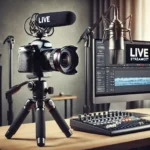Master Advanced Streaming Techniques with Multi-Camera Setup
Introduction
Live streaming has become an essential tool for businesses, creators, and event organizers looking to engage with their audiences in real-time. As online video consumption continues to rise, standing out amidst the competition requires leveraging advanced streaming techniques. Among these, multi-camera live streaming is a game-changer. This method transforms how events, webinars, and productions are presented, offering viewers a dynamic and highly engaging experience.
In this article, we’ll dive into the concept of multi-camera live streaming, the challenges it addresses, actionable methods to get started, and the benefits it brings to your live broadcast production.
The Problem: Why Single-Camera Streams Fall Short
Single-camera live streams have been a popular choice for their simplicity and low cost. However, they often lack the dynamism needed to keep audiences captivated for extended periods. Here are some challenges associated with single-camera live streaming:
- Limited Perspectives: A single camera angle can make your content feel static, limiting the storytelling potential of your broadcast.
- Reduced Engagement: With minimal visual variety, viewers may lose interest, leading to lower retention rates.
- Professional Limitations: In professional settings such as conferences, concerts, or sports events, one camera simply cannot capture the entire scope or complexity of the production.
- Hindered Brand Perception: Brands aiming for a polished and professional image may find single-camera streams falling short of their standards.
Clearly, to meet the diverse needs of modern audiences and deliver high-quality live streams, broadcasters need an advanced solution.
The Solution: Multi-Camera Live Streaming Techniques
Multi-camera live streaming allows you to use multiple cameras to capture and switch between various angles, scenes, or views during a live broadcast. Utilizing advanced streaming techniques not only elevates your production value but also creates a more engaging experience for your audience.
Actionable Steps to Implement Multi-Camera Live Streaming
-
Plan Your Stream Setup
- Identify the purpose of your live stream and the types of camera angles needed. For example, a concert may require wide shots for the stage, close-ups of the performers, and audience reactions.
- Map out the ideal placement of cameras to ensure comprehensive coverage.
-
Choose the Right Equipment
- Cameras: Invest in 2-3 cameras with good resolution and low-light capabilities. DSLR cameras, camcorders, or even high-end webcams can be used depending on your budget.
- Tripods/Stabilizers: Ensure cameras are securely mounted for stable shots.
- Audio: Use external microphones or an audio mixer for professional audio quality.
-
Set Up a Video Switcher
- Hardware Switcher: Devices like the ATEM Mini or Roland V-1HD allow operators to easily switch between camera feeds.
- Software Switcher: Advanced tools like OBS Studio, vMix, or Wirecast also provide switching functionalities alongside features like overlays and transitions.
-
Configure Your Streaming Software
- Use streaming software compatible with multi-camera setups. Platforms like OBS Studio or Streamlabs OBS allow the integration of multiple video sources.
- Customize your layout for seamless switching between feeds and add branding elements such as logos or banners.
-
Ensure a Strong Internet Connection
- Multi-camera streaming can consume significant bandwidth. Ensure upload speeds of at least 5-10 Mbps for high-definition streams.
-
Rehearse and Test
- Conduct a full rehearsal before going live. Test camera angles, lighting, audio quality, and stream performance.
- Involve a dedicated team member to monitor the live stream and troubleshoot any issues.
- Engage and Interact
- Take advantage of multi-camera views to engage your audience. Incorporate behind-the-scenes footage, close-ups, and interactive visuals.
Tools and Resources for Multi-Camera Streaming
- Internal Links: Explore our guides on choosing the best streaming software and enhancing live streaming with overlays.
- External Resources: Learn more about video switchers on Blackmagic Design.
The Benefits of Adopting Multi-Camera Live Streaming
Switching from single-camera setups to multi-camera live streaming offers numerous advantages:
-
Enhanced Viewer Experience
- Dynamic camera angles make your content visually engaging and captivating.
-
Professional-Grade Production
- Multi-camera streams emulate TV-style broadcasts, creating a polished look that elevates your brand.
-
Better Storytelling
- Switching between angles allows you to emphasize key moments, provide context, and make your content more informative and entertaining.
-
Increased Viewer Retention
- Studies show that visually stimulating content keeps viewers engaged for longer periods.
-
Improved Replay Value
- Multi-camera angles add depth and variety to recorded streams, making them more enjoyable to watch on-demand.
Conclusion
Multi-camera live streaming is no longer reserved for large-scale productions. With the right tools, planning, and implementation of advanced streaming techniques, anyone can elevate their live broadcasts to meet professional standards. By offering dynamic perspectives and engaging visuals, you’ll keep your viewers invested in your content and set yourself apart in the ever-growing live streaming landscape.
Ready to take your live streaming to the next level? Start experimenting with multi-camera setups today and watch as your audience engagement soars. For more tips and insights on advanced streaming techniques, explore our comprehensive guides here.
